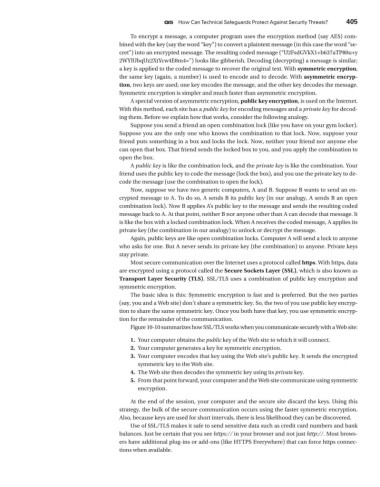Page 437 - Using MIS
P. 437
Q5 How Can Technical Safeguards Protect Against Security Threats? 405
To encrypt a message, a computer program uses the encryption method (say AES) com-
bined with the key (say the word “key”) to convert a plaintext message (in this case the word “se-
cret”) into an encrypted message. The resulting coded message (“U2FsdGVkX1+b637aTP80u+y
2WYlUbqUz2XtYcw4E8m4=”) looks like gibberish. Decoding (decrypting) a message is similar;
a key is applied to the coded message to recover the original text. With symmetric encryption,
the same key (again, a number) is used to encode and to decode. With asymmetric encryp-
tion, two keys are used; one key encodes the message, and the other key decodes the message.
Symmetric encryption is simpler and much faster than asymmetric encryption.
A special version of asymmetric encryption, public key encryption, is used on the Internet.
With this method, each site has a public key for encoding messages and a private key for decod-
ing them. Before we explain how that works, consider the following analogy.
Suppose you send a friend an open combination lock (like you have on your gym locker).
Suppose you are the only one who knows the combination to that lock. Now, suppose your
friend puts something in a box and locks the lock. Now, neither your friend nor anyone else
can open that box. That friend sends the locked box to you, and you apply the combination to
open the box.
A public key is like the combination lock, and the private key is like the combination. Your
friend uses the public key to code the message (lock the box), and you use the private key to de-
code the message (use the combination to open the lock).
Now, suppose we have two generic computers, A and B. Suppose B wants to send an en-
crypted message to A. To do so, A sends B its public key (in our analogy, A sends B an open
combination lock). Now B applies A’s public key to the message and sends the resulting coded
message back to A. At that point, neither B nor anyone other than A can decode that message. It
is like the box with a locked combination lock. When A receives the coded message, A applies its
private key (the combination in our analogy) to unlock or decrypt the message.
Again, public keys are like open combination locks. Computer A will send a lock to anyone
who asks for one. But A never sends its private key (the combination) to anyone. Private keys
stay private.
Most secure communication over the Internet uses a protocol called https. With https, data
are encrypted using a protocol called the Secure Sockets Layer (SSL), which is also known as
Transport Layer Security (TLS). SSL/TLS uses a combination of public key encryption and
symmetric encryption.
The basic idea is this: Symmetric encryption is fast and is preferred. But the two parties
(say, you and a Web site) don’t share a symmetric key. So, the two of you use public key encryp-
tion to share the same symmetric key. Once you both have that key, you use symmetric encryp-
tion for the remainder of the communication.
Figure 10-10 summarizes how SSL/TLS works when you communicate securely with a Web site:
1. Your computer obtains the public key of the Web site to which it will connect.
2. Your computer generates a key for symmetric encryption.
3. Your computer encodes that key using the Web site’s public key. It sends the encrypted
symmetric key to the Web site.
4. The Web site then decodes the symmetric key using its private key.
5. From that point forward, your computer and the Web site communicate using symmetric
encryption.
At the end of the session, your computer and the secure site discard the keys. Using this
strategy, the bulk of the secure communication occurs using the faster symmetric encryption.
Also, because keys are used for short intervals, there is less likelihood they can be discovered.
Use of SSL/TLS makes it safe to send sensitive data such as credit card numbers and bank
balances. Just be certain that you see https:// in your browser and not just http://. Most brows-
ers have additional plug-ins or add-ons (like HTTPS Everywhere) that can force https connec-
tions when available.

